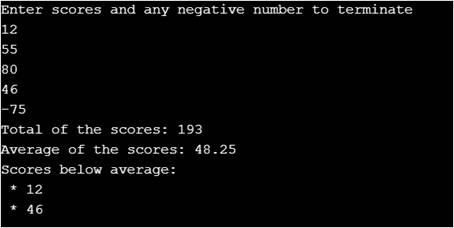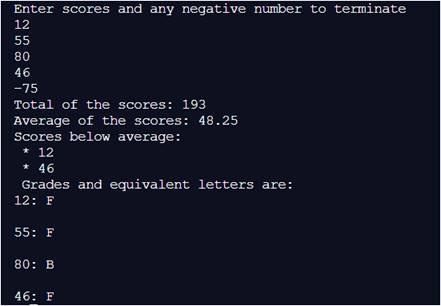
(Statistics) a. Write a C++
b. Extend the program written for Exercise 1a to display each grade and its letter equivalent, using the following scale:
(a)
Program Plan:
- Declaremax and count variables of int data type.
- Declare sumand average variables of double data type
- Declare an array grade[100] of double data type.
- Use for loop to read all the array elements from the user.
- Use if statementto check the negative value.
- Calculatethe sum and average of all the user entered score.
- Display the calculated results to the user.
- Use for loop to calculate grades below the average.
- Use if condition to find the grades below the average.
- Display the grades below average by using the asterisk in the front of the grade(*).
- int main() method function is used to perform all the tasks.
Program Description: The main purpose of the program is to read all scores from the user, storing the scores in the grade[] array, calculating the sum and average of all the entered elements and to display the grades below average by using the asterisk in the front of grade(*).
Explanation of Solution
Program code:
//including required header files
#include<iostream>
usingnamespacestd;
//main method
int main()
{
//declaring required variables
int max = 100, count =0;
double sum=0, average=0;
//Declaring the array to store value of grades
double grade[max];
cout<<"Enter scores and any negative number to terminate"<<endl;
//This loop will execute maximum of 100
//while loop
while(count<max){
//Reading inputs from user
cin>>grade[count];
//if the number is negative then loop is terminated
if(grade[count]<0)
break;
//adding the entered sum
sum = sum + grade[count];
//increnting loop variable
count++;
}//end of while loop
//Calculating average
average = sum/count;
//displaying Calculated results to the user
cout<<"Total of the scores: "<<sum<<endl;
cout<<"Average of the scores: "<<average<<endl;
cout<<"Scores below average: ";
//for loop to find the score below average
for(int i=0; i<count; i++)
{
//if the score is below average
if(grade[i]<average)
{
cout<<"\n * "<<grade[i];
}
}
return0;
}//end of the main method
Sample output:

(b)
Program Plan:
- Declaremax and count variables of int data type.
- Declare sumand average variables of double data type
- Declare an array grade[100] of double data type.
- Use for loop to read all the array elements from the user.
- Use if statement to check the negative value.
- Calculate the sum and average of all the user entered score.
- Display the calculated results to the user.
- Use for loop to calculate grades below the average.
- Use if condition to find the grades below the average.
- Display the grades below average by using the asterisk in the front of grade(*).
- Use if condition to find the grade.
- int main() method function is used to perform all the task.
Program Description: The main purpose of the program is to modify the program code given in part (a) so that the code will also display the grade letters to the user.
Explanation of Solution
Program code:
//including required header files
#include<iostream>
usingnamespacestd;
//main method
int main()
{
//declaring required variables
int max = 100, count =0;
double sum=0, average=0;
//Declaring the array to store value of grades
double grade[max];
cout<<"Enter scores and any negative number to terminate"<<endl;
//This loop will execute maximum of 100
//while loop
while(count<max){
//Reading inputs from user
cin>>grade[count];
//if the number is negative then loop is terminated
if(grade[count]<0)
break;
//adding the entered sum
sum = sum + grade[count];
//increnting loop variable
count++;
}//end of while loop
//Calculating average
average = sum/count;
//displaying Calculated results to the user
cout<<"Total of the scores: "<<sum<<endl;
cout<<"Average of the scores: "<<average<<endl;
cout<<"Scores below average: ";
//for loop to find the score below average
for(int i=0; i<count; i++)
{
//if the score is below average
if(grade[i]<average)
{
cout<<"\n * "<<grade[i];
}
}
//displaying message to the user
cout<<"\n Grades and equivalent letters are: ";
//for loop
for(int i=0; i<count; i++)
{
//if grades are between 90 and 100
if(grade[i]<=100&& grade[i]>=90){
cout<<" \n"<<grade[i]<<": A"<<endl;
}
/*if grades are greater than or equal to 80 and less than 90*/
elseif(grade[i]<90&& grade[i]>=80){
cout<<" \n"<<grade[i]<<": B"<<endl;
}
/*if grades are greater than or equal to 70 and less than 80*/
elseif(grade[i]<80&& grade[i]>=70){
cout<<" \n"<<grade[i]<<": C"<<endl;
}
/*if grades are greater than or equal to 60 and less than 70*/
elseif(grade[i]<70&& grade[i]>=60)
{
cout<<" \n"<<grade[i]<<": D"<<endl;
}
//otherwise
else{
cout<<" \n"<<grade[i]<<": F"<<endl;
}
}
return0;
}//end of the main method
Sample output:

Want to see more full solutions like this?
Chapter 7 Solutions
C++ for Engineers and Scientists
- CSE330: Discrete Mathematics 1. In the classes, we discussed three forms of floating number representations as given below, (1) Standard/General Form, (2) Normalized Form, (3) Denormalized Form. Now, let's take, ẞ = 2, m = 3, emin = -2 and emax = 3. Based on these, answer the following: (a) (b) (c) (d) What are the maximum/largest numbers that can be stored in the system by these three forms defined above? (express your answer in decimal values) What are the non-negative minimum/smallest numbers that can be stored in the system by the denormalized form? (express your answer in decimal values) How many numbers (both non-negative and negative) can be represented in the above mentioned system using the general form? Explain your answer. Find all the decimal numbers for e = 3 and e = 2 in denormalized form, plot them on a real line and prove that all the numbers are not equally spaced. Write the equally spaced sets for the number line you drew. show your answer in Don't use any Al tool pen…arrow_forward3.[20 pts] Find the minimum equivalent circuit for the one shown below (show your work): DAB 0 f(A,B,C,D)arrow_forwardSuppose your computer is responding very slowly to information requests from the Internet. You observe that your network gateway shows high levels of network activity even though you have closed your e-mail client, Web browser, and all other programs that access the Internet. What types of malwares could cause such symptoms? What steps can you take to check whether malware has gained access to your system? What tools can you use at each step? If you identify malware, what ways might it have entered your system? How can you restore your PC to safe operation, including the special software tools you may use?arrow_forward
- R languagearrow_forwardUsing R languagearrow_forwardCompare the security services provided by a digital signature (DS) with those of a message authentication code (MAC). Assume that Oscar can observe all messages sent between Rina and Naseem. Oscar has no knowledge of any keys but the public one, in the case of DS. State whether DS and MAC protect against each attack and, if they do, how. The value auth(x) is computed with a DS or a MAC algorithm. In each scenario, assume the message M = x#####auth(x). (Message integrity) Rina has the textual data x = “Transfer $1000 to Mark” to send to Naseem. To ensure the integrity of the data, Rina generates auth(x), forms a message M, and then sends M in cleartext to Naseem. Oscar intercepts the message and replaces “Mark” with “Oscar.” Will Naseem detect this in the case of either DS or MAC? If yes, how will Naseem detect it? If not, why? (Replay) Rina has the textual data x = “Transfer $1000 to Mark” to send to Naseem. To ensure the integrity of the data, Rina generates auth(x), forms a message…arrow_forward
- I need to resolve the following....You are trying to convince your boss that your company needs to invest in a license for MS-Project (project management software from Microsoft) before beginning a systems project. What arguments would you give her?arrow_forwardWhat are the four types of feasibility? what is the issues addressed by each feasibility component.arrow_forwardI would like to get ab example of a situation where Agile Methods might be preferable versus the traditional SDLC? What are the characteristics of this situation that give Agile Methods an advantage?arrow_forward
- What is a functional decomposition diagram? what is a good example of a high level task being broken down into tasks in at least two lower levels (three levels in all).arrow_forwardWhat are the advantages to using a Sytems Analysis and Design model like the SDLC vs. other approaches?arrow_forward3. Problem Description: Define the Circle2D class that contains: Two double data fields named x and y that specify the center of the circle with get methods. • A data field radius with a get method. • A no-arg constructor that creates a default circle with (0, 0) for (x, y) and 1 for radius. • A constructor that creates a circle with the specified x, y, and radius. • A method getArea() that returns the area of the circle. • A method getPerimeter() that returns the perimeter of the circle. • • • A method contains(double x, double y) that returns true if the specified point (x, y) is inside this circle. See Figure (a). A method contains(Circle2D circle) that returns true if the specified circle is inside this circle. See Figure (b). A method overlaps (Circle2D circle) that returns true if the specified circle overlaps with this circle. See the figure below. р O со (a) (b) (c)< Figure (a) A point is inside the circle. (b) A circle is inside another circle. (c) A circle overlaps another…arrow_forward
 C++ for Engineers and ScientistsComputer ScienceISBN:9781133187844Author:Bronson, Gary J.Publisher:Course Technology Ptr
C++ for Engineers and ScientistsComputer ScienceISBN:9781133187844Author:Bronson, Gary J.Publisher:Course Technology Ptr C++ Programming: From Problem Analysis to Program...Computer ScienceISBN:9781337102087Author:D. S. MalikPublisher:Cengage Learning
C++ Programming: From Problem Analysis to Program...Computer ScienceISBN:9781337102087Author:D. S. MalikPublisher:Cengage Learning Microsoft Visual C#Computer ScienceISBN:9781337102100Author:Joyce, Farrell.Publisher:Cengage Learning,
Microsoft Visual C#Computer ScienceISBN:9781337102100Author:Joyce, Farrell.Publisher:Cengage Learning,- Programming Logic & Design ComprehensiveComputer ScienceISBN:9781337669405Author:FARRELLPublisher:Cengage



